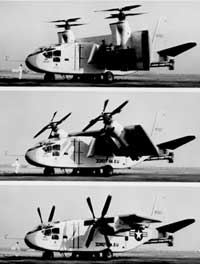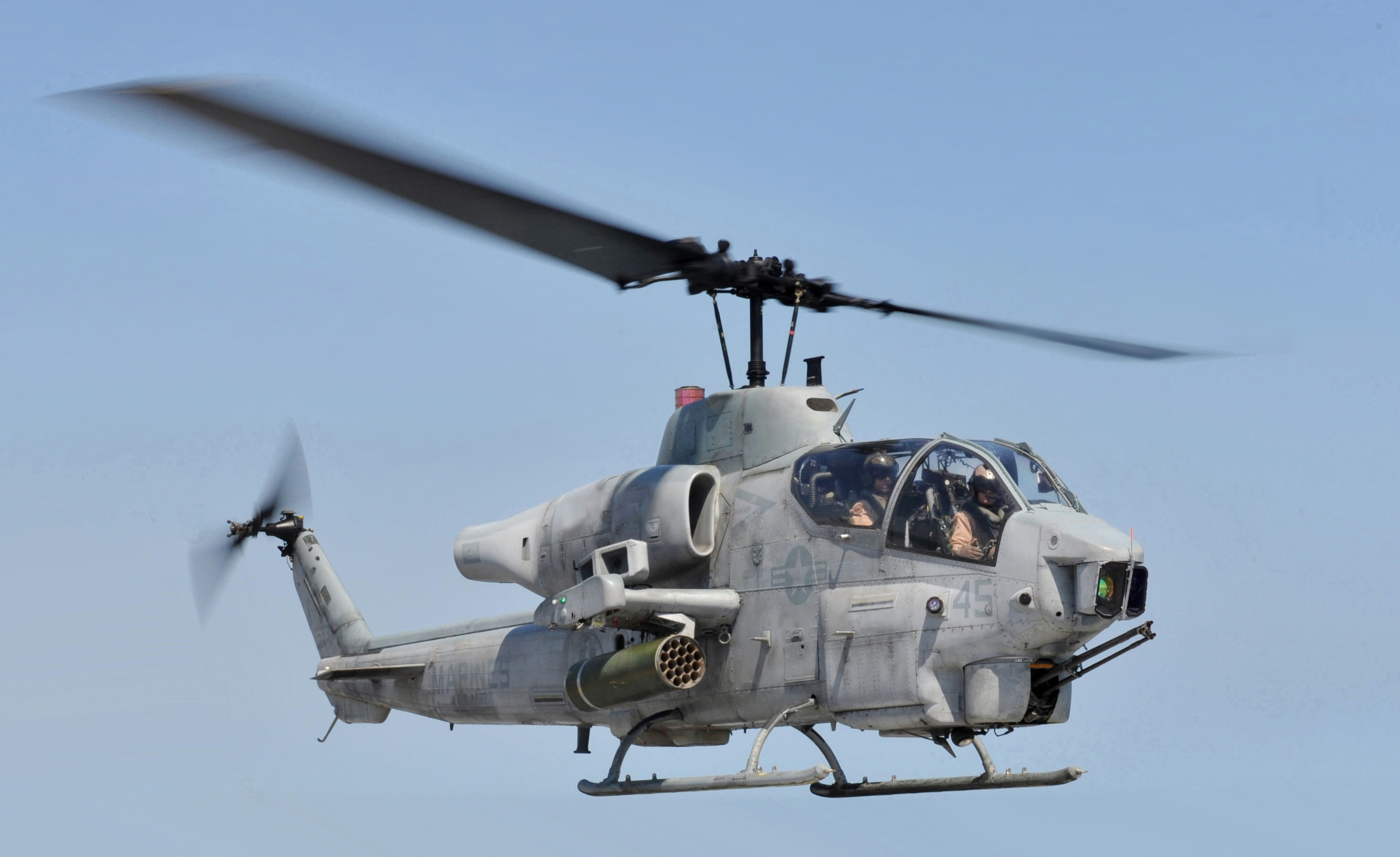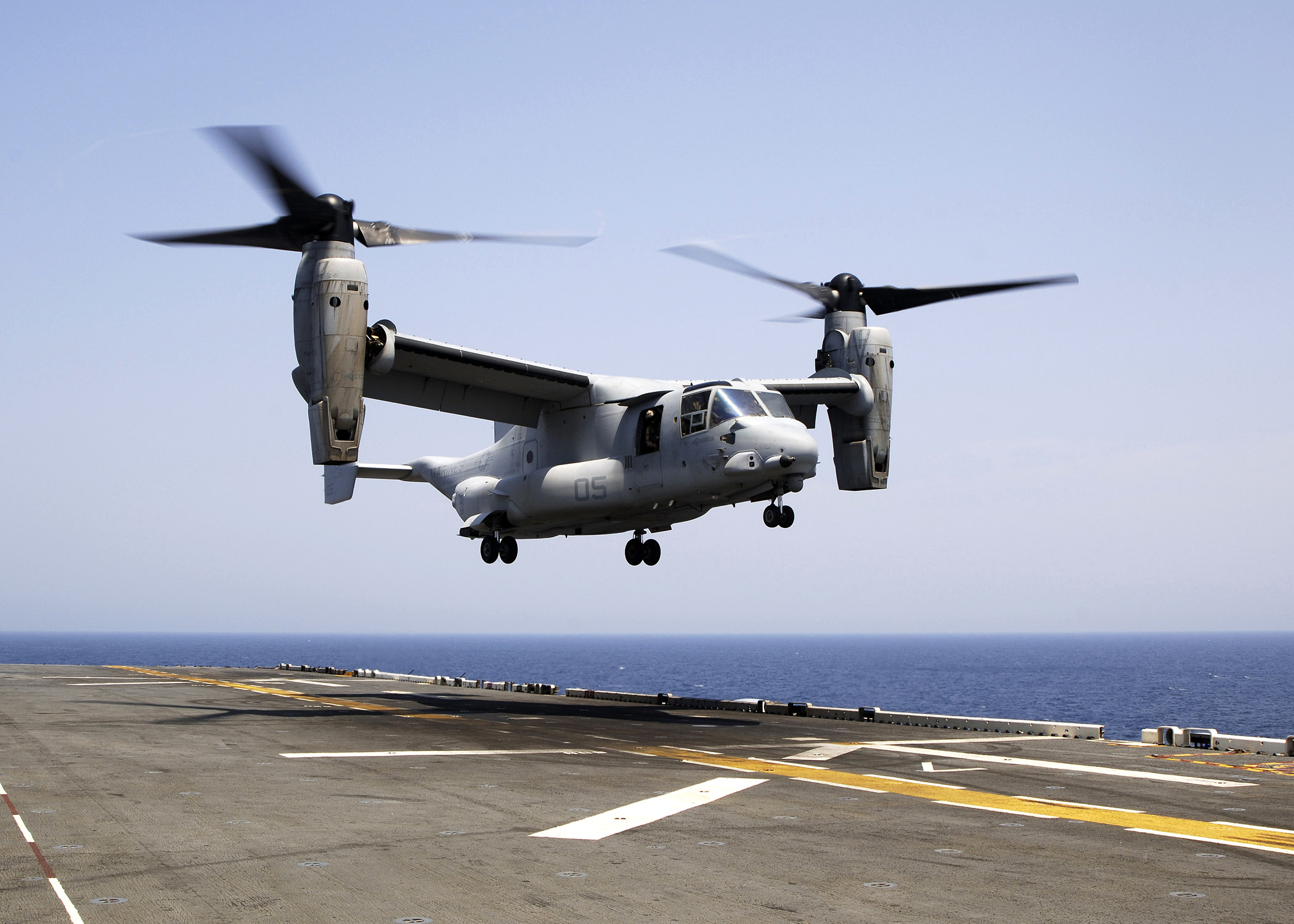|
Tiltrotor
A tiltrotor is an aircraft which generates lift and propulsion by way of one or more powered rotors (sometimes called ''proprotors'') mounted on rotating shafts or nacelles usually at the ends of a fixed wing. Almost all tiltrotors use a transverse rotor design, with a few exceptions that use other multirotor layouts. Tiltrotor design combines the VTOL capability of a helicopter with the speed and range of a conventional fixed-wing aircraft. For vertical flight, the rotors are angled so the plane of rotation is horizontal, generating lift the way a normal helicopter rotor does. As the aircraft gains speed, the rotors are progressively tilted forward, with the plane of rotation eventually becoming vertical. In this mode the rotors provide thrust as a propeller, and the airfoil of the fixed wings takes over providing the lift via the forward motion of the entire aircraft. Since the rotors can be configured to be more efficient for propulsion (e.g. with root-tip twi ... [...More Info...] [...Related Items...] OR: [Wikipedia] [Google] [Baidu] |
XV-15 N703NA USCG
The Bell XV-15 is an American tiltrotor VTOL aircraft. It was the second successful experimental tiltrotor aircraft and the first to demonstrate the concept's high speed performance relative to conventional helicopters. Development Early VTOL rotor aircraft The idea of building VTOL aircraft using helicopter-like rotors at the wingtips originated in the 1930s. The first design resembling modern tiltrotors was patented by George Lehberger in May 1930, but he did not develop the concept further. In World War II, a German prototype called the Focke-Achgelis Fa 269 was developed starting in 1942, but it never flew. Two prototypes that made it to flight were the one-seat Transcendental Model 1-G and two-seat Transcendental Model 2, both powered by single reciprocating engines. Development started on the Model 1-G in 1947, and it flew in 1954. The Model 1-G flew until a crash in Chesapeake Bay on 20 July 1955, destroying the prototype aircraft but not seriously injuring the pilot. ... [...More Info...] [...Related Items...] OR: [Wikipedia] [Google] [Baidu] |
VTOL
A vertical take-off and landing (VTOL) aircraft is one that can take off and land vertically without relying on a runway. This classification can include a variety of types of aircraft including helicopters as well as thrust-vectoring fixed-wing aircraft and other hybrid aircraft with powered rotors such as cyclogyros/cyclocopters and gyrodynes. Some VTOL aircraft can operate in other modes as well, such as CTOL (conventional take-off & landing), STOL (short take-off & landing), or STOVL (short take-off & vertical landing). Others, such as some helicopters, can only operate as VTOL, due to the aircraft lacking landing gear that can handle taxiing. VTOL is a subset of V/STOL (vertical or short take-off & landing). Some lighter-than-air aircraft also qualify as VTOL aircraft, as they can hover, takeoff and land with vertical approach/departure profiles. Electric vertical takeoff and landing aircraft, or eVTOLs, are being developed along with more autonomous flight con ... [...More Info...] [...Related Items...] OR: [Wikipedia] [Google] [Baidu] |
Tiltwing
A tiltwing aircraft features a wing that is horizontal for conventional forward flight and rotates up for vertical takeoff and landing. It is similar to the tiltrotor design where only the propeller and engine rotate. Tiltwing aircraft are typically fully capable of VTOL operations.Markman, Steve and Bill Holder. "Tilt-Wing VTOL Systems". ''Straight Up: A History of Vertical Flight''. Schiffer Publishing, 2000. . The tiltwing design offers certain advantages in vertical flight relative to a tiltrotor. Because the slipstream from the rotor strikes the wing on its smallest dimension, the tiltwing is able to apply more of its engine power to lifting the aircraft. For comparison, the V-22 Osprey tiltrotor loses about 10% of its thrust to interference from the wings. Another advantage of tiltwing aircraft is the ease of transition between VTOL and horizontal flight modes. A tiltrotor must first fly forwards like a helicopter, building airspeed until wing lift is sufficient to all ... [...More Info...] [...Related Items...] OR: [Wikipedia] [Google] [Baidu] |
Helicopter Rotor
A helicopter main rotor or rotor system is the combination of several rotary wings (rotor blades) with a control system, that generates the aerodynamic lift force that supports the weight of the helicopter, and the thrust that counteracts aerodynamic drag in forward flight. Each main rotor is mounted on a vertical mast over the top of the helicopter, as opposed to a helicopter tail rotor, which connects through a combination of drive shaft(s) and gearboxes along the tail boom. The blade pitch is typically controlled by the pilot using the helicopter flight controls. Helicopters are one example of rotary-wing aircraft (rotorcraft). The name is derived from the Greek words ''helix'', helik-, meaning spiral; and ''pteron'' meaning wing. Design principles Overview The helicopter rotor is powered by the engine, through the transmission, to the rotating mast. The mast is a cylindrical metal shaft that extends upward from—and is driven by—the transmission. At the top of the m ... [...More Info...] [...Related Items...] OR: [Wikipedia] [Google] [Baidu] |
Helicopter
A helicopter is a type of rotorcraft in which lift and thrust are supplied by horizontally spinning rotors. This allows the helicopter to take off and land vertically, to hover, and to fly forward, backward and laterally. These attributes allow helicopters to be used in congested or isolated areas where fixed-wing aircraft and many forms of STOL (Short TakeOff and Landing) or STOVL (Short TakeOff and Vertical Landing) aircraft cannot perform without a runway. In 1942, the Sikorsky R-4 became the first helicopter to reach full-scale production.Munson 1968.Hirschberg, Michael J. and David K. Dailey"Sikorsky". ''US and Russian Helicopter Development in the 20th Century'', American Helicopter Society, International. 7 July 2000. Although most earlier designs used more than one main rotor, the configuration of a single main rotor accompanied by a vertical anti-torque tail rotor (i.e. unicopter, not to be confused with the single-blade monocopter) has become the most ... [...More Info...] [...Related Items...] OR: [Wikipedia] [Google] [Baidu] |
Transverse Rotor
Transverse rotor aircraft have two large horizontal rotor assemblies mounted side by side. Single-rotor helicopters (unicopters) need an additional tail rotor or tail exhaust to neutralize the reactional angular momentum produced by the main rotor. Transverse rotor helicopters, however, use counter-rotating rotors, with each cancelling out the other's torque. Counter-rotating rotor blades also won't collide with and destroy each other if they flex into the other rotor's pathway. In addition, transverse rotor configuration has the advantage of higher payload with shorter blades, since there are two sets working to provide lift. Also, all of the power from the engines can be used for lift, whereas a single-rotor helicopter must divert part of its engine power to generate tail thrust. Transverse rotor design with rotatable nacelles are known as tiltrotors while designs where the whole wing rotates are known as tiltwings. List of transverse rotor aircraft Transverse-m ... [...More Info...] [...Related Items...] OR: [Wikipedia] [Google] [Baidu] |
Focke-Achgelis Fa 269
The Focke-Achgelis Fa 269 was a tiltrotor VTOL aircraft project designed by Henrich Focke. Development Conceived as a single-seat fighter, the Fa 269 project resulted from a design study order issued by the Reich Air Ministry to Focke-Achgelis in 1941. The order called for a local defence fighter which would combine the VTOL capabilities of a helicopter with the speed and economy of a conventional fixed-wing aircraft. A large amount of wind tunnel testing was undertaken, along with work on gearboxes, drives and power-pivoting mechanisms, and a full-scale mock-up of the aircraft was built to demonstrate the VTOL concept, but much of this was destroyed by Allied bombing raids and all work was shelved in 1944, when Focke-Achgelis estimated that there was little likelihood of a practical prototype being available before 1947. Design A mid-wing monoplane, the Fa 269 was to have been powered by a single BMW 801 air-cooled radial engine The radial engine is a reciprocating ty ... [...More Info...] [...Related Items...] OR: [Wikipedia] [Google] [Baidu] |
Helicopter Rotor
A helicopter main rotor or rotor system is the combination of several rotary wings (rotor blades) with a control system, that generates the aerodynamic lift force that supports the weight of the helicopter, and the thrust that counteracts aerodynamic drag in forward flight. Each main rotor is mounted on a vertical mast over the top of the helicopter, as opposed to a helicopter tail rotor, which connects through a combination of drive shaft(s) and gearboxes along the tail boom. The blade pitch is typically controlled by the pilot using the helicopter flight controls. Helicopters are one example of rotary-wing aircraft (rotorcraft). The name is derived from the Greek words ''helix'', helik-, meaning spiral; and ''pteron'' meaning wing. Design principles Overview The helicopter rotor is powered by the engine, through the transmission, to the rotating mast. The mast is a cylindrical metal shaft that extends upward from—and is driven by—the transmission. At the top of the m ... [...More Info...] [...Related Items...] OR: [Wikipedia] [Google] [Baidu] |
Aircraft
An aircraft is a vehicle that is able to fly by gaining support from the air. It counters the force of gravity by using either static lift or by using the dynamic lift of an airfoil, or in a few cases the downward thrust from jet engines. Common examples of aircraft include airplanes, helicopters, airships (including blimps), Glider (aircraft), gliders, Powered paragliding, paramotors, and hot air balloons. The human activity that surrounds aircraft is called ''aviation''. The science of aviation, including designing and building aircraft, is called ''aeronautics.'' Aircrew, Crewed aircraft are flown by an onboard Aircraft pilot, pilot, but unmanned aerial vehicles may be remotely controlled or self-controlled by onboard computers. Aircraft may be classified by different criteria, such as lift type, Powered aircraft#Methods of propulsion, aircraft propulsion, usage and others. History Flying model craft and stories of manned flight go back many centuries; however, t ... [...More Info...] [...Related Items...] OR: [Wikipedia] [Google] [Baidu] |
World War II
World War II or the Second World War, often abbreviated as WWII or WW2, was a world war that lasted from 1939 to 1945. It involved the World War II by country, vast majority of the world's countries—including all of the great powers—forming two opposing military alliances: the Allies of World War II, Allies and the Axis powers. World War II was a total war that directly involved more than 100 million Military personnel, personnel from more than 30 countries. The major participants in the war threw their entire economic, industrial, and scientific capabilities behind the war effort, blurring the distinction between civilian and military resources. Air warfare of World War II, Aircraft played a major role in the conflict, enabling the strategic bombing of population centres and deploying the Atomic bombings of Hiroshima and Nagasaki, only two nuclear weapons ever used in war. World War II was by far the List of wars by death toll, deadliest conflict in hu ... [...More Info...] [...Related Items...] OR: [Wikipedia] [Google] [Baidu] |
Maximum Takeoff Weight
The maximum takeoff weight (MTOW) or maximum gross takeoff weight (MGTOW) or maximum takeoff mass (MTOM) of an aircraft is the maximum weight at which the pilot is allowed to attempt to take off, due to structural or other limits. The analogous term for rockets is gross lift-off mass, or GLOW. MTOW is usually specified in units of kilograms or pounds. MTOW is the heaviest weight at which the aircraft has been shown to meet all the airworthiness requirements applicable to it. MTOW of an aircraft is fixed and does not vary with altitude, air temperature, or the length of the runway to be used for takeoff or landing. Maximum permissible takeoff weight or "regulated takeoff weight", varies according to flap setting, altitude, air temperature, length of runway and other factors. It is different from one takeoff to the next, but can never be higher than the MTOW. Certification standards Certification standards applicable to the airworthiness of an aircraft contain many requiremen ... [...More Info...] [...Related Items...] OR: [Wikipedia] [Google] [Baidu] |







